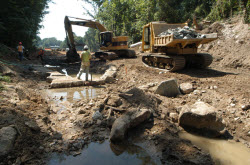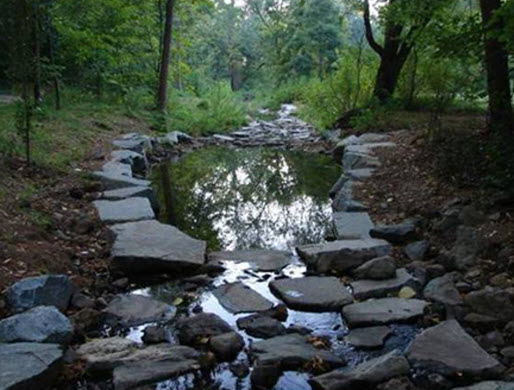

 An urban stream is a formerly natural waterway that flows through a heavily populated area. Citizens and industry contribute to urban stream pollution. In many large cities like Baltimore, construction projects in the past have altered the flow and/or course of urban streams to prevent localized flooding. Some of these techniques included lining streambeds with concrete or other hardscape materials, and/or diverting the stream into culverts and storm drains. Thus, many urban streams run underground for at least a portion of their length. These modifications have often resulted in loss of habitat for fish and other species, caused downstream flooding due to alterations of flood plains, and further deteriorated water quality.
An urban stream is a formerly natural waterway that flows through a heavily populated area. Citizens and industry contribute to urban stream pollution. In many large cities like Baltimore, construction projects in the past have altered the flow and/or course of urban streams to prevent localized flooding. Some of these techniques included lining streambeds with concrete or other hardscape materials, and/or diverting the stream into culverts and storm drains. Thus, many urban streams run underground for at least a portion of their length. These modifications have often resulted in loss of habitat for fish and other species, caused downstream flooding due to alterations of flood plains, and further deteriorated water quality.
The mission of the Surface Water Management Division is to maintain and improve the City’s stormwater collection and conveyance system, stream health and habitat, and protect open waterways. This includes the implementation of the City’s Municipal Separate Storm Sewer System Permit (MS4)*. The Surface Water Management Division provides planning, engineering, and maintenance of the streams and open and closed waterways within the City in an effort to protect the environment and to protect public health and safety. The development of the capital program for stormwater and environmental facilities is the responsibility of the Surface Water Management Division with the assistance of Bureau’s fiscal staff.
Our major goal is the implementation of watershed restoration plans required by the MS4 Permit and in improving the integrity of the storm drain, open channel, and stream systems. Additional goals:
* MS4 Permit – Renewed every 5 years, it sets the legal ground rules for discharges into our waterways.
Watershed planning and plans, under the watershed management program, rely on input from citizens and community partners, especially local watershed associations. Citizen activism helps to protect Baltimore City water resources.
Baltimore City consists of four major watersheds. SWMD staff continually evaluates protection and restoration strategies for the natural resources throughout our watersheds. The City has developed approximately 12 technical watershed plans and studies for the watersheds.
To restore a watershed, there must be a Watershed Plan. This plan is a mandated blueprint for meeting the Clean Water Act and our NPDES MS4 permit. A watershed restoration plan includes:
The City monitors the effectiveness of the restoration practices as per Part III.H of the NPDES MS4 Permit.
The Stony Run Example

Success from the first Stony Run stream restoration project was documented in an article about the return of frogs published in the Baltimore Sun.
The City has noticed a significant "improvement" in biodiversity at Stony Run since the restoration. American toads were in a mating frenzy in May of 2009 in one new channel pool. Green frogs have been calling during the summer in an excavated spill pond that now contains pickerelweed from plantings and perhaps some self-generation. Crayfish are sighted more frequently.
With birds, the most interesting sightings were Solitary Sandpipers at the same toad pool and on the other side of Wynhurst along the stream channel. The same birds were on several occasions in indicating there was enough aquatic food to sustain an extended stay before heading north. This is the first time sandpipers have been spotted in this portion of the stream. Redwing blackbirds have also moved into the marsh area and bred for the first time.
A May 2009 bird count along Stony Run was exceptional with about 61 species noted between 7:00 a.m. and 10:30 am. While some trees were removed for the restoration, the resulting biodiversity is positive. It seems entirely likely that Barred Owls could be here now because of the restoration.
The great number of wetland plantings and natural generation of wetland plants are truly impressive. DPW is in the midst of determining what species are establishing themselves naturally with the aid of transect plots.